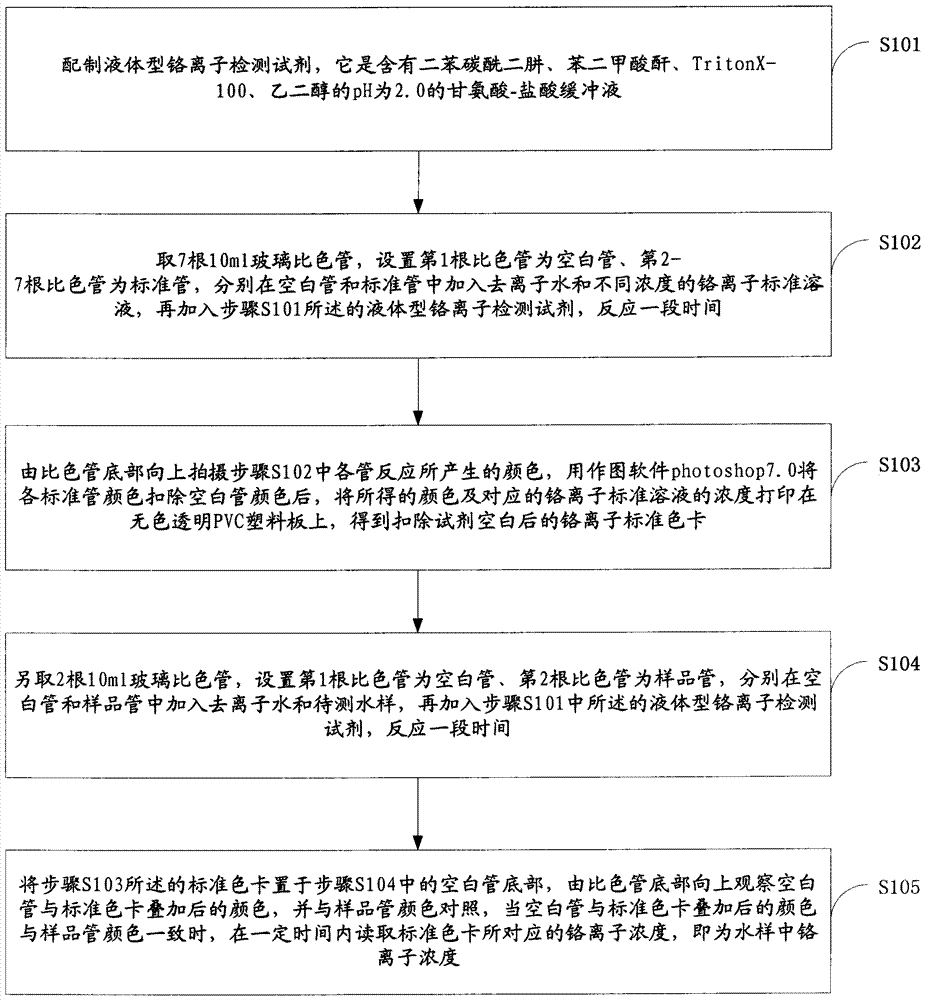A rapid on-site detection method for chromium ions in water that can eliminate the influence of reagent blanks
A detection method, the technology of chromium ions, is applied in the direction of material analysis by observing the influence on chemical indicators, and analysis by making materials undergo chemical reactions, which can solve the problems of difficult effective control of dissolution time and inability to eliminate reagent blanks, etc. Achieve the effect of high accuracy, easy operation, and eliminate influence
- Summary
- Abstract
- Description
- Claims
- Application Information
AI Technical Summary
Problems solved by technology
Method used
Image
Examples
Embodiment 1
[0039] Step 1. Weigh 2g of diphenylcarbazide and 20g of phthalic anhydride, add 800ml of 150mmol / L pH2.0 glycine-hydrochloric acid buffer and stir to dissolve, then add 0.02ml TritonX-100 and 10ml of ethylene glycol, stir to dissolve Afterwards, dilute to 1000ml with 150mmol / L pH2.0 glycine-hydrochloric acid buffer solution to obtain 1000ml containing 2g / L diphenylcarbazide, 20g / L phthalic anhydride, 0.02ml / L TritonX-100, 10ml / L Ethylene glycol 150mmol / L pH2.0 glycine-hydrochloric acid buffer is a liquid chromium ion detection reagent;
[0040] Step 2: Take seven 10ml glass colorimetric tubes, set the first colorimetric tube as a blank tube, and the second to seventh colorimetric tubes as standard tubes, add 10ml deionized water and 10ml into the blank tube and standard tube respectively Chromium ion standard solution with a concentration of 0.05mg / L, 0.10mg / L, 0.20mg / L, 0.40mg / L, 0.60mg / L, 0.80mg / L, and then add the liquid chromium ion detection reagent described in step 1 0...
Embodiment 2
[0046] Step 1. Weigh 6g of diphenylcarbazide and 40g of phthalic anhydride, add 800ml of 150mmol / L pH2.0 glycine-hydrochloric acid buffer and stir to dissolve, then add 0.05ml TritonX-100 and 20ml of ethylene glycol, stir to dissolve Afterwards, dilute to 1000ml with 150mmol / L pH2.0 glycine-hydrochloric acid buffer solution to obtain 1000ml containing 6g / L diphenylcarbazide, 40g / L phthalic anhydride, 0.05ml / L TritonX-100, 20ml / L Ethylene glycol 150mmol / L pH2.0 glycine-hydrochloric acid buffer is a liquid chromium ion detection reagent;
[0047] Step 2: Take seven 10ml glass colorimetric tubes, set the first colorimetric tube as a blank tube, and the second to seventh colorimetric tubes as standard tubes, add 10ml deionized water and 10ml into the blank tube and standard tube respectively Chromium ion standard solution with a concentration of 0.05mg / L, 0.10mg / L, 0.20mg / L, 0.40mg / L, 0.60mg / L, 0.80mg / L, and then add the liquid chromium ion detection reagent described in step 1 0...
Embodiment 3
[0053] Step 1. Weigh 10g of diphenylcarbazide and 60g of phthalic anhydride, add 800ml of 150mmol / L pH2.0 glycine-hydrochloric acid buffer and stir to dissolve, then add 0.08ml of TritonX-100 and 30ml of ethylene glycol, stir to dissolve Afterwards, dilute to 1000ml with 150mmol / L pH2.0 glycine-hydrochloric acid buffer solution to obtain 1000ml containing 10g / L diphenylcarbazide, 60g / L phthalic anhydride, 0.08ml / L TritonX-100, 30ml / L Ethylene glycol 150mmol / L pH2.0 glycine-hydrochloric acid buffer is a liquid chromium ion detection reagent;
[0054] Step 2: Take seven 10ml glass colorimetric tubes, set the first colorimetric tube as a blank tube, and the second to seventh colorimetric tubes as standard tubes, add 10ml deionized water and 10ml into the blank tube and standard tube respectively Chromium ion standard solution with a concentration of 0.05mg / L, 0.10mg / L, 0.20mg / L, 0.40mg / L, 0.60mg / L, 0.80mg / L, and then add the liquid chromium ion detection reagent described in step...
PUM
| Property | Measurement | Unit |
|---|---|---|
| volume | aaaaa | aaaaa |
| thickness | aaaaa | aaaaa |
Abstract
Description
Claims
Application Information
 Login to View More
Login to View More - R&D
- Intellectual Property
- Life Sciences
- Materials
- Tech Scout
- Unparalleled Data Quality
- Higher Quality Content
- 60% Fewer Hallucinations
Browse by: Latest US Patents, China's latest patents, Technical Efficacy Thesaurus, Application Domain, Technology Topic, Popular Technical Reports.
© 2025 PatSnap. All rights reserved.Legal|Privacy policy|Modern Slavery Act Transparency Statement|Sitemap|About US| Contact US: help@patsnap.com


